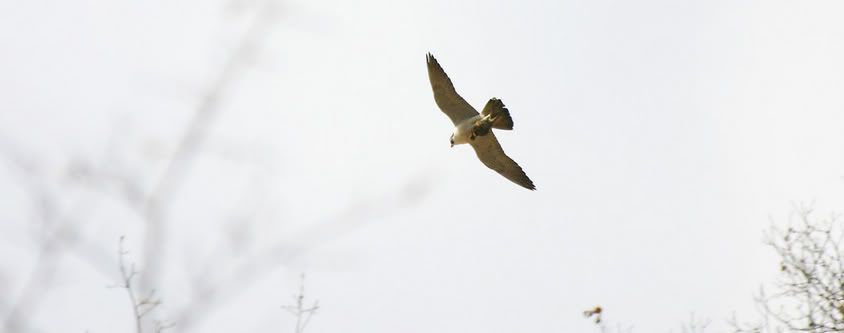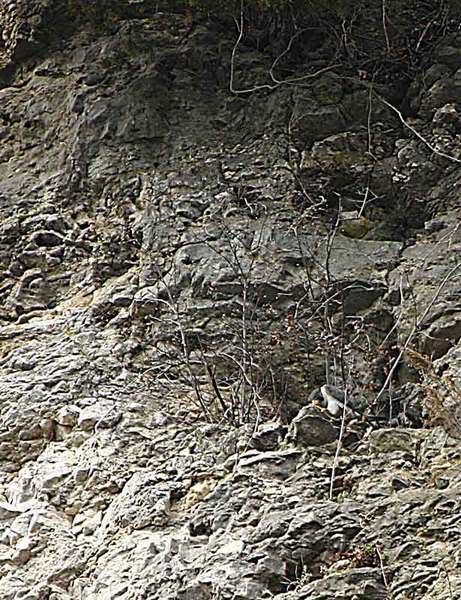Adventures in Birding, Part 1
The weather had promised sunshine, warm temps and light breezes. Add to that my day off from work, and you have the formula for a day filled with Adventures in Birding. So many, in fact, that it will take more than this one post to share them all.
Last week at our Coulee Audubon meeting, we were treated to the story of Peregrine Falcon recovery by Bob Anderson, who has worked in concert with WEnergies to place nest boxes on power plant stacks along the Mississippi River. I had a special interest in his story, because my father's engineering design company was named "Falcon Engineering." A task given to me by Dad, one I never completed to the satisfaction of either of us, was to create a logo for his company that incorporated a Peregrine Falcon forming the letter "F."
That, and they are just plain cool! Peregrine Falcons were at one point nearly extinct in North America, going the way of the Bald Eagle. When Bob first became involved with them, there were only a few pairs left at all, and much controversy surrounded the captive breeding program started. There were those who felt they should not be held captive, but allowed to pass into the annals of extirpation with dignity. Thankfully, that didn't happen.
Peregrine Falcons are cliff dwellers, making their eyries on rock walls facing open water. The Upper Mississippi Wildlife Refuge in which I live is prime habitat for these birds. Initially, and continuing to this day, they were choosing to nest on high buildings in urban areas or power plant smokestacks. They still do. However, in 1996, Bob designed a "rock box," a nest box that looked like a rock ledge on the inside, to encourage Peregrines to become cliff dwellers again. That box was placed high on a bluff overlooking the river at Effigy Mounds National Monument, and from that placement, a population of Peregrines has gone on to nest in bluff face locations on the river. Several of these locations are within an hour's drive of me. Yesterday, I headed out to one of those locations, Leo's Bluff between Harpers Ferry and Waukon Junction in Iowa.
I'd never ventured south of Lansing Iowa, one of my favorite river towns. Take X52 south from there, and you enter a place apart from others. The road winds along the river before climbing to higher agricultural land, then dropping down to hug the river once more. Along the way, a picturesque old dilapidated farmhouse, a hillside church with an old cemetary out front and boathouses along the river are part of the scene. Reaching Leo's Bluff, I pulled off after scaring away three Turkey Vultures who, knowing how ugly they are, just didn't want to stay around for photos!
Immediately looking up, I saw him--the male Peregrine Falcon, perched on an overhanging branch, surveying his kingdom. Not long after I arrived, Bob Anderson pulled up. He set up his scope, which gave me a really up close look at this magnificent bird. Bob was trying to read the band as well as locate the female. We heard her. We just couldn't see her. These birds successfully fledged chicks last year for the first time at this location.
Suddenly, the bird began to sound off. A Turkey Vulture was flying too close to the cliff face, and away he went! These are not large birds, about 16-20 inches long. Yet at speeds of 60mph, he attacked this eagle sized bird, successfully running it off his territory.
At one point, he flew off for no obvious reason that we could see. When I looked at my very crummy photos last night, it's apparent now. He grabbed a small bird from the air and likely cached it.

Try as we might, the female could not be located. Still, the male gave us plenty to appreciate, commanding his world from on high amid this rocky, inaccessible location. Giving pursuit to passing birds much larger than he, tearing apart a cached bird for lunch, feathers flying, calling a warning to any who thought to approach, I could only watch in awe. The weathermen had been wrong. The sun disappeared. Raindrops began to fall, slowly at first, then with more persistence. I watched the Peregrine, threatened species, ruling his world for about an hour before moving on. I'll watch him again soon. I've seen the Peregrines on the smokestacks and the tall buildings, but seeing them in their original wild environment is something special. A real adventure in birding.

At home in his bluffside (eating on the far right)
Last week at our Coulee Audubon meeting, we were treated to the story of Peregrine Falcon recovery by Bob Anderson, who has worked in concert with WEnergies to place nest boxes on power plant stacks along the Mississippi River. I had a special interest in his story, because my father's engineering design company was named "Falcon Engineering." A task given to me by Dad, one I never completed to the satisfaction of either of us, was to create a logo for his company that incorporated a Peregrine Falcon forming the letter "F."
That, and they are just plain cool! Peregrine Falcons were at one point nearly extinct in North America, going the way of the Bald Eagle. When Bob first became involved with them, there were only a few pairs left at all, and much controversy surrounded the captive breeding program started. There were those who felt they should not be held captive, but allowed to pass into the annals of extirpation with dignity. Thankfully, that didn't happen.
Peregrine Falcons are cliff dwellers, making their eyries on rock walls facing open water. The Upper Mississippi Wildlife Refuge in which I live is prime habitat for these birds. Initially, and continuing to this day, they were choosing to nest on high buildings in urban areas or power plant smokestacks. They still do. However, in 1996, Bob designed a "rock box," a nest box that looked like a rock ledge on the inside, to encourage Peregrines to become cliff dwellers again. That box was placed high on a bluff overlooking the river at Effigy Mounds National Monument, and from that placement, a population of Peregrines has gone on to nest in bluff face locations on the river. Several of these locations are within an hour's drive of me. Yesterday, I headed out to one of those locations, Leo's Bluff between Harpers Ferry and Waukon Junction in Iowa.
I'd never ventured south of Lansing Iowa, one of my favorite river towns. Take X52 south from there, and you enter a place apart from others. The road winds along the river before climbing to higher agricultural land, then dropping down to hug the river once more. Along the way, a picturesque old dilapidated farmhouse, a hillside church with an old cemetary out front and boathouses along the river are part of the scene. Reaching Leo's Bluff, I pulled off after scaring away three Turkey Vultures who, knowing how ugly they are, just didn't want to stay around for photos!
Immediately looking up, I saw him--the male Peregrine Falcon, perched on an overhanging branch, surveying his kingdom. Not long after I arrived, Bob Anderson pulled up. He set up his scope, which gave me a really up close look at this magnificent bird. Bob was trying to read the band as well as locate the female. We heard her. We just couldn't see her. These birds successfully fledged chicks last year for the first time at this location.
Suddenly, the bird began to sound off. A Turkey Vulture was flying too close to the cliff face, and away he went! These are not large birds, about 16-20 inches long. Yet at speeds of 60mph, he attacked this eagle sized bird, successfully running it off his territory.
At one point, he flew off for no obvious reason that we could see. When I looked at my very crummy photos last night, it's apparent now. He grabbed a small bird from the air and likely cached it.

Try as we might, the female could not be located. Still, the male gave us plenty to appreciate, commanding his world from on high amid this rocky, inaccessible location. Giving pursuit to passing birds much larger than he, tearing apart a cached bird for lunch, feathers flying, calling a warning to any who thought to approach, I could only watch in awe. The weathermen had been wrong. The sun disappeared. Raindrops began to fall, slowly at first, then with more persistence. I watched the Peregrine, threatened species, ruling his world for about an hour before moving on. I'll watch him again soon. I've seen the Peregrines on the smokestacks and the tall buildings, but seeing them in their original wild environment is something special. A real adventure in birding.

At home in his bluffside (eating on the far right)



3 Comments:
WOW! great pics!
By Anonymous, at 11:33 AM
Anonymous, at 11:33 AM
Stunning photos, Gwyn! I know these birds must be truly majestic in person.
By Amy, at 8:33 PM
Amy, at 8:33 PM
excellent photos.
By squire, at 4:59 AM
squire, at 4:59 AM
Post a Comment
<< Home